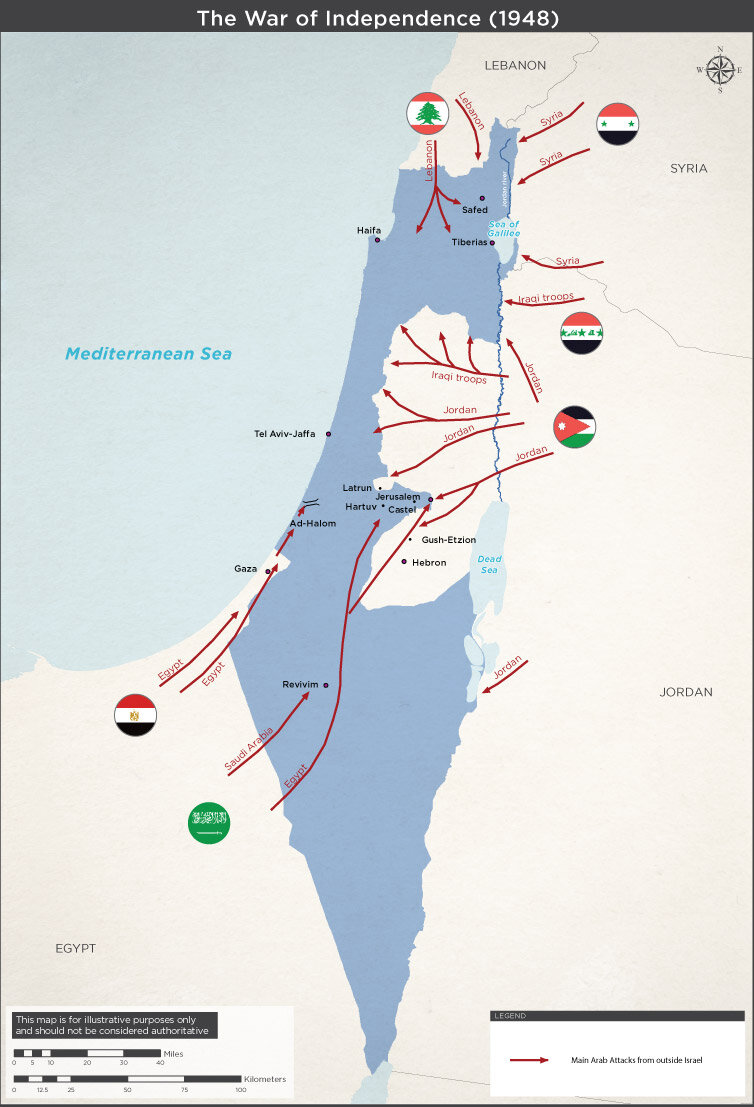Within hours of declaring independence, Israel was invaded by five Arab armies. In the middle of an existential war, the government made its first decision: to proclaim Israel open for Jewish immigration.
THE PLOT
Three fronts opened up against Israel on May 15, 1948, ,barely 12 hours after Israel had been declared. Egypt invaded through Gaza in the south, Lebanon and Syria attacked from the north, and the Iraqi and Transjordanian armies invaded from the east.
The situation in Jerusalem was dire. 100,000 Jews were trapped under siege, including 1,600 in the Old City. The city held enormous symbolic, historic, and emotional importance to Israel. In order to reach Jerusalem, the Jewish forces first had to seize the main road leading to the city from the coast — in itself a huge and dangerous undertaking. To do that Israel had to capture the fortress at Latrun, which overlooked the road. On May 25 the fight for Latrun began. Over the next two months, and at a cost of hundreds of casualties, Israel failed to seize the fortress, but later succeeded in opening the road.
The fight for the Old City was a desperate house-to-house struggle between a small group of Jewish fighters and the Jordanian Arab Legion. By the end of May the Jews were forced to surrender, the few remaining fighters were taken prisoner, the rest were expelled, and just about every last building in the Jewish Quarter was razed to the crowd. In one of only a handful of times in history, the Western Wall was made totally inaccessible to the Jews.
The first act of the new Israeli government was to abolish all restrictions on Jewish immigration, immediately opening up the country for Jews to arrive from anywhere in the world — especially the several hundred thousand Holocaust refugees still languishing in Europe.
THE PEOPLE
King Abdullah I: king of Transjordan (later the Kingdom of Jordan). Was reluctant to attack Israel but couldn’t refuse to join his fellow Arab leaders in the war.
Esther Cailingold: 22 year-old Haganah fighter who defended the Old City. Mortally wounded in the fight, she died two weeks after Israel’s independence.
Nissim Gini: 10 year-old Jewish boy living in the Old City, who carried messages during the desperate fighting and was shot dead by a sniper. Recognized today as the youngest Israeli soldier ever killed in battle.
David Ben Gurion: first Prime Minister of Israel.
Golda Meir: pre-state leader, close confidante of Ben Gurion, and future Prime Minister. Held secret talks with King Abdullah to encourage him not to attack Israel.
Yitzhak Rabin: seasoned and highly-respected 26 year-old officer leading the Jewish forces trying to capture the strategic road to Jerusalem. Future Israeli Prime Minister.
Ariel Sharon: 20 year-old native-born Israeli fighter wounded at the battle of Latrun. Went on to be one of Israel’s most fierce-some, effective, ruthless, and controversial warriors. He served as Prime Minister from 2001-2006.
Yigal Yadin: top commander of the Haganah, went on to become one of Israel’s most famous military leaders and its most revered archaeologist.
THE BIG IDEAS
The 1947 UN Partition Plan called for a Jewish state and independent Arab (Palestinian) state, with Jerusalem as an international zone. Why was only the Jewish state created? One of the several reasons is that King Abdullah I of Transjordan, which controlled Jerusalem and the West Bank, didn’t want a Palestinian state to rival his power or take his territory. He much preferred to be neighbors with the Jews than with an antagonistic Palestinian state next door.
The fight for Jerusalem. The Jews were facing starvation and a steady onslaught of artillery strikes, with few weapons. The failed battle for Latrun became a foundational battle upon which Israelis projected various perspectives around the War of Independence, from heroism to competency to the role of Holocaust survivors during the fight; how you felt about Latrun was often an indicator of your political viewpoint. Meanwhile, the loss of the Old City was an enormous blow to Jewish morale across the whole country.
Abolishing all restrictions on Jewish immigration fulfilled a key Zionist goal, and ensured that the new Jewish State would be a safe-haven for Jews whenever it was needed. It was a significant symbolic decision that had important practical implications. Where would the small state house everyone? What does the focus on Jewish immigration say about who belongs, and who doesn’t, in the new State of Israel?
FUN FACTS
There were 650,000 Jews in Israel on the day independence was declared.
1% of Israel’s population was killed in the War of Independence.
Golda Meir disguised herself as an Arab woman in order to sneak across the border to meet in secret with King Abdullah I.
Israel’s very first act as a national government was to abolish all restrictions on Jewish immigration.
© Jason Harris 2020
Basic map showing the Arab invasion of Israel upon independence, May, 1948. Map credit: Israeli Ministry of Foreign Affairs.
More detailed map of the invasion. The blue lines represent the UN Partition borders between the Jewish and Arab states. Map credit: Wikipedia
Nissim Gini, 10 year-old boy killed during the battle for the Old City. Source: Zein Shver wordpress blog.



